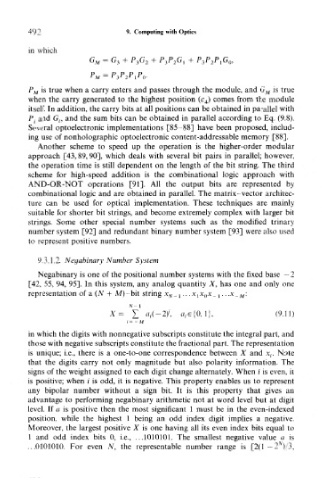Page 507 - Introduction to Information Optics
P. 507
492 9. Computing with Optics
in which
G M = G 3 + P 3G 2 + P 3 P 2 G, -f P.P 2P 1G 0,
P M = P 3P 2P 1P 0.
P M is true when a carry enters and passes through the module, and G M is true
when the carry generated to the highest position (c 4) comes from the module
itself. In addition, the carry bits at all positions can be obtained in parallel with
P, and G,, and the sum bits can be obtained in parallel according to Eq. (9.8).
Several optoelectronic implementations [85^ 88] have been proposed, includ-
ing use of nonholographie optoelectronic content-addressable memory [88].
Another scheme to speed up the operation is the higher-order modular
approach [43,89,90], which deals with several bit pairs in parallel; however,
the operation time is still dependent on the length of the bit string. The third
scheme for high-speed addition is the combinational logic approach with
AND-OR-NOT operations [91]. All the output bits are represented by
combinational logic and are obtained in parallel. The matrix-vector architec-
ture can be used for optical implementation. These techniques are mainly
suitable for shorter bit strings, and become extremely complex with larger bit
strings. Some other special number systems such as the modified trinary
number system [92] and redundant binary number system [93] were also used
to represent positive numbers.
9,3.1.2. Negabinary Number System
Negabinary is one of the positional number systems with the fixed base — 2
[42, 55, 94, 95]. In this system, any analog quantity X, has one and only one
representation of a (JV + M) -bit string x w _ l... x lx 0x_ t ...x_ M:
N- 1
X= X «.-(-2)'', ««e{0,1}, (9.11)
i = - M
in which the digits with nonnegative subscripts constitute the integral part, and
those with negative subscripts constitute the fractional part. The representation
is unique; i.e., there is a one-to-one correspondence between X and x,-. Note
that the digits carry not only magnitude but also polarity information. The
signs of the weight assigned to each digit change alternately. When i is even, it
is positive; when i is odd, it is negative. This property enables us to represent
any bipolar number without a sign bit. It is this property that gives an
advantage to performing negabinary arithmetic not at word level but at digit
level. If a is positive then the most significant 1 must be in the even-indexed
position, while the highest 1 being an odd index digit implies a negative.
Moreover, the largest positive X is one having all its even index bits equal to
1 and odd index bits 0, i.e., ...1010101. The smallest negative value a is
N
...0101010. For even N, the representable number range is [2(1 — 2 )/3,

